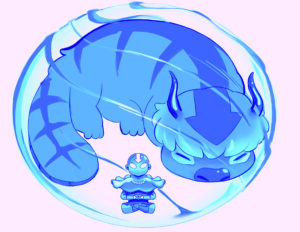A beloved early 2000s TV show, Avatar: the Last Airbender has recently spawned a live-action Netflix adaptation. Many early 2000s kids can remember watching the original show, and as someone who grew up adoring it, I have many thoughts on the new adaptation. However, today I will be looking at just the changes in the personalities of characters Sokka, Katara, and Azula.
The first thing that caught my eye was the way the show deprives the characters of the negative traits that give them their personalities. These negative traits ended up either being resolved or adding depth to their choices in the original show. In the case of the daughter of the villain Fire Lord Ozai, Azula, who instead of losing characteristics, gains some more, this is not so bad. In the new Netflix adaptation of Avatar the Last Airbender, I am pleased that they develop Azula’s character more. In the original animated show, Azula does not appear until season two as an antagonist. However, in the adaptation, they introduce her much earlier. Azula is instead a character introduced in the first season and is concerned about her older brother, Zuko, retrieving the Avatar. The show highlights Azula’s influences from afar as she helps a captain to oppose Zuko. Another cool thing the adapted show does is give Azula and her father more screen time in the first season. You see her father (Fire Lord Ozai) slowly manipulating her through training and moulding her to his image. This shows more of her character as it depicts how badly she just wants to please her father and become the best. This was an amazing choice as it gives more context as to why she is later seen and described as “crazy” and “going crazy”. Later in the show, Azula is seen as becoming incredibly violent, obsessive and merciless, exactly how her father wanted. Fire Lord Ozai slowly manipulates his younger child into becoming a weapon and a dangerous force to be reckoned with. That is all due to her jealousy of Zuko as the heir and the desire to please her father. This increases sympathy and understanding for Azula’s character, making her more interesting as a person.
Katara and Sokka both experience major character changes in the first season of the adaptation. Katara and Sokka are the young teenage water tribe siblings who find twelve year old Aang —the titular Avatar — and become his closest friends and protectors. Katara in the original show is fiery-tempered, angry about the loss of her mother, responsible, and has the nerve to challenge the system and challenge a waterbending master to a duel as a child. However, in the adaptation she is more calm and reserved, experiencing more sadness than anger. This is a tad infuriating, as it deprives the audience of the depth and complexity of her character. This change pulls her more into the stereotypical role of the mother character, which happens to many female characters. Katara in the original show does care for the others, but her hot temper is something that drags her into trouble quite often.
A controversial adaptation might be how Sokka is portrayed in the new adaptation. Sokka’s character is more responsible and mature in the newer adaptation than he was originally. He was goofier, and believed that he was more responsible than he was. The original Sokka dealt with misogynistic tendencies, angering many characters through the first season. Being as misogynistic as he was gave him a major flaw that later gets resolved, and shows how characters are relatable people who change and can evolve. Sokka is originally very misogynistic until he meets the Kyoshi warriors—a group of all women warriors—who put him in his place. When he later meets Princess Yue of the Northern Water Tribe, and after speaking with her about spirituality and remembering what the Kyoshi warriors taught him, he realizes how capablewomen are. He learns from his mistakes, grows as a person, and becomes a feminist in his own way. Choosing to omit this from the new adaptation takes away an important challenge that Sokka overcomes: his own thoughts and behaviors. By deciding not to include his flaws in the recent adaptation, it feels like the directors are deciding to ignore how people can evolve, grow, and become better.

The recent Netflix adaptation of Avatar: The Last Airbender highlights a new approach in how they portray characters such as Sokka, Katara, and Azula. In this new approach, the three characters are each either deepened or simplified. While Azula’s character gets better, two beloved characters get worse. Katara and Sokka lose some of their negative traits which made them more relatable and added a layer to their personalities. These changes can incite discussions of changes in characters in adaptations of older shows and movies, emphasizing the need for balance that respects the original while engaging new viewers with some new ideas. Ultimately, the series makes a valid case for discussion on character changes and what is necessary to change, and what is not.





